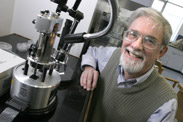
Chemistry researchers at Montreal’s McGill University have developed a key step towards making a cheap, portable, paper-based filter coated with silver nanoparticles to be used to prevent the spread of disease in emergency situations, such as floods and earthquakes.
“Silver has been used to clean water for a very long time. The Greeks and Romans kept their water in silver jugs,” says Derek Gray, a professor in McGill’s Department of Chemistry. But though silver is used to get rid of bacteria in a variety of settings, from bandages to antibacterial socks, no one has used it systematically to clean water before. “It’s because it seems too simple,” says Gray.
Gray’s team, which included graduate student Theresa Dankovich, coated thick (0.5mm) hand-sized sheets of an absorbent porous paper with silver nanoparticles and then poured live bacteria through it. “Viewed in an electron microscope, the paper looks as though there are silver polka dots all over,” says Dankovich, “and the neat thing is that the silver nanoparticles stay on the paper even when the contaminated water goes through.” Even when the paper contains a small quantity of silver (5.9 mg of silver per dry gram of paper), the filter is able to kill nearly all the bacteria and produce water that meets the standards set by the US Environmental Protection Agency (EPA).
The filter is not envisaged as a routine water purification system, but as a way of providing rapid small-scale assistance in emergency settings. “It works well in the lab,” says Gray, “now we need to improve it and test it in the field.”
The research was funded by the National Sciences and Engineering Council of Canada (NSERC) and the work is part of the NSERC Sentinel Bioactive Paper Network.
The team’s findings were recently published in the Journal of Environmental Science & Technology. For an abstract of the article, click here.









